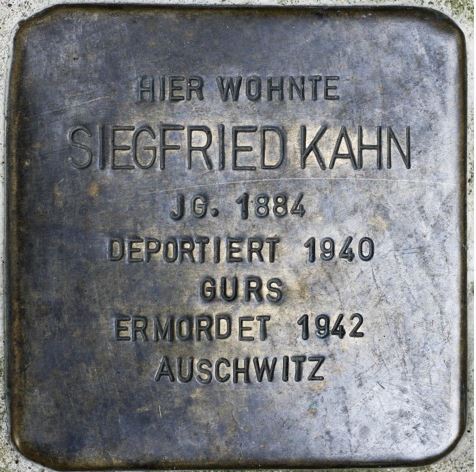
Siegfried Kahn
SIEGFRIED KAHN was born on January 29, 1884 in Sulzburg as the son of Heinrich Kahn and Mathilde, née Weil. The siblings Hugo, Hilde and Julius Kahn grew up with him in the Sulzburg corner house of Ernst-Barth-Gasse / Gustav-Weill-Strasse, diagonally opposite the synagogue, where their father’s leather shop is also located.
The training to become a businessman – presumably in his parents‘ business – was followed by a job in Müllheim (?) in the textile industry as a traveling salesman on an employed basis.
On June 27, 1928, SIEGFRIED married HILDA KAHN. Gatschet 334, who returned to Müllheim from Switzerland with her little son Albert after her husband’s death in 1925 and worked in her father’s textile business. In keeping with his previous work as a traveling salesman, he joins his new relative’s company in the same position. And apparently, at the beginning of the 1930s, in addition to the private relationship, the business collaboration also got off to a good start in the rented rooms at Müllheimer Hauptstrasse 111, where the company and apartment are located.
But as a result of the “Aryanization” that was “successfully” propagated by the Nazi government from 1933 onwards – ie the expropriation of all businesses and businesses with owners who were Jewish – the financial situation of the KAHN family in southern Baden also deteriorated rapidly . Declared “pests of the German people,” they are forced to move to Werderstrasse in Müllheim, which is less centrally located and therefore not exposed to all anti-Semitic hate campaigns. When the threat situation here did not subside, they had to give up the business completely in 1936. With financial ruin starting this year, their only option is to move to the even cheaper Gällelegässle on the outskirts of the city.
On November 12, 1938, SIEGFRIED KAHN was arrested and deported to the Dachau concentration camp. The aim of the week-long stay with violence and brutality towards the people there is to cause the Jewish prisoners to leave Germany immediately after their expropriation.
As life became more and more unbearable for all of Müllheim’s Jewish people (and especially for him as a returnee from Dachau concentration camp!), the KAHN couple found themselves forced to leave the city in August 1939. They are moving to Freiburg. First to Rheinstraße 17, then to Breisacher Straße 17 to the Wertheimer family. The parents‘ hope of finding accommodation with their son Albert, who is a Swiss citizen and has found a job there, now remains the overriding goal. The majority of the household goods are packed by the Freiburg company Mengler and stored with them until the planned emigration.
Aber dieses Ansinnen zerschlägt sich auf grausame Weise. Am 22.10.1940 werden SIEGFRIED und HILDA KAHN verhaftet und von Freiburg aus mit 6.500 badischer und saarpfälzischer Jüdinnen und Juden in das südfranzösische Internierungslager KZ-Gurs deportiert.
Ein ganzes Jahr werden sie in der drangvollen Enge dieses Lagers unter den erbärmlichsten Bedingungen überleben müssen. Dann ein überraschender Lichtblick: Sie können das riesige Lager Gurs verlassen und in ein kleineres, weniger reglementiertes und mit etwas mehr Freiheiten ausgestattetes Lager wechseln. Sohn Albert berichtet darüber und über die darauffolgende Zeit: „Am 25. November 1941 konnte ich meine Eltern befreien und sie in ein katholisches Heim Maison de la Roche, Chansaye, Département Rhône unterbringen. Sie blieben in diesem Heim bis zum 14. September 1942. Dann wurden sie in das KZ-Lager Camp de Rivesaltes, Pyrenäen deportiert“. Wiederum ein riesiges Lager mit dortigem Aufenthalt vom 17. bis 28. September 1942. An diesem letzten Tag werden sie mit 69 anderen Männern und Frauen in das KZ- Drancy – bei Paris – in die von Deutschen besetzte Zone verschleppt.
SIEGFRIED KAHN und seine Frau müssen über einen Monat in der Trostlosigkeit dieses Pariser Abschiebungslagers – meist in den Tod – verbringen. Am 4.11.1942 werden sie mit dem „convoi 40“ zusammen mit 1.000 anderen jüdischen Menschen verschiedener Nationalität in das KZ- Auschwitz-Birkenau deportiert. Im Memorial de la déportation des Juifs de France (s.u.) sind beide auf der Liste „Drancy 1“ registriert, es ist dies ihre letzte Spur. Seitdem sind sie verschollen. Das Amtsgericht Freiburg erklärt sie am 11.1.1960 für tot. Todestag am 25.11. 1942.
Vermutlich sind sie gleich nach ihrer Ankunft im KZ-Auschwitz-Birkenau in den Gaskammern ermordet worden. SIEGFRIED KAHN wurde 58 Jahre alt.
Quellen: Staatsarchiv Freiburg F 196/1-11516 und -5888; G 540/5-13214; F 166/3-2978. Sekundär: Jüdische Spuren in Sulzburg. Zwei Hefte, herausgegeben von der „Initiative Jüdische Spuren in Sulzburg“, 2013. Rolf Schuhbauer: „Nehmt dieses kleine Heimatstück“. Spuren und Stationen der Leidenswege von Müllheimer und Badenweilemer Juden zwischen 1933 und 1945, Eggingen 2001. Peter Künzel, Von Gurs über Chansaye in die Freiheit ? Über einen dramatischen Rettungsversuch badischer jüdischer Internierter im unbesetzten Frankreich 1940-1944. In: Badische Heimat 2/2009.
Zusätze: Albert Gatschet, 1958 wohnhaft Biel Dufourstr. 56. 2 Kinder von (1958) 4 und 14 Jahren. Er erzählt in den Akten s.o. ausführlich die Geschehnisse.
- Hausratsversteigerung bei Kahns Breisacherstr. 17 am 17.5.1941; der Ertrag: 672 Mark, Original in den Akten. Das Schicksal von Siegfrieds nächsten Verwandten: Bruder Hugo verstirbt 1958 in NY; Bruder Julius verstirbt 1920 in Sulzburg; Schwester Hilde verh. Lederer verstirbt 1958 in NY; und der Vater ebenfalls in NY am 1.3.1941.
- STOLPERSTEINE für SIEGFRIED und HILDA KAHN im Müllheimer Gälle- legässle sind bereits vorhanden.
- Secondary literature: Mémorial de la deportation des Juifs de France, ed. by Serge Klarsfeld – more precise names on the Internet.
Research and text: Peter Künzel, STOLPERSTEINE project in FREIBURG.



